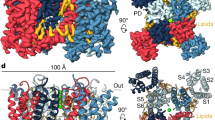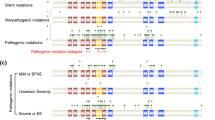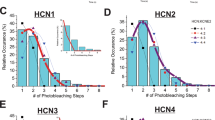Abstract
The KCNH voltage-dependent potassium channels (ether-à-go-go, EAG; EAG-related gene, ERG; EAG-like channels, ELK) are important regulators of cellular excitability1,2,3 and have key roles in diseases such as cardiac long QT syndrome type 2 (LQT2)4, epilepsy5, schizophrenia6 and cancer7. The intracellular domains of KCNH channels are structurally distinct from other voltage-gated channels. The amino-terminal region contains an eag domain, which is composed of a Per-Arnt-Sim (PAS) domain and a PAS-cap domain8, whereas the carboxy-terminal region contains a cyclic nucleotide-binding homology domain (CNBHD), which is connected to the pore through a C-linker domain. Many disease-causing mutations localize to these specialized intracellular domains, which underlie the unique gating and regulation of KCNH channels9. It has been suggested that the eag domain may regulate the channel by interacting with either the S4–S5 linker or the CNBHD8,10. Here we present a 2 Å resolution crystal structure of the eag domain–CNBHD complex of the mouse EAG1 (also known as KCNH1) channel. It displays extensive interactions between the eag domain and the CNBHD, indicating that the regulatory mechanism of the eag domain primarily involves the CNBHD. Notably, the structure reveals that a number of LQT2 mutations at homologous positions in human ERG, in addition to cancer-associated mutations in EAG channels, localize to the eag domain–CNBHD interface. Furthermore, mutations at the interface produced marked effects on channel gating, demonstrating the important physiological role of the eag domain–CNBHD interaction. Our structure of the eag domain–CNBHD complex of mouse EAG1 provides unique insights into the physiological and pathophysiological mechanisms of KCNH channels.
This is a preview of subscription content, access via your institution
Access options
Subscribe to this journal
Receive 51 print issues and online access
$199.00 per year
only $3.90 per issue
Buy this article
- Purchase on Springer Link
- Instant access to full article PDF
Prices may be subject to local taxes which are calculated during checkout




Similar content being viewed by others
References
Warmke, J., Drysdale, R. & Ganetzky, B. A distinct potassium channel polypeptide encoded by the Drosophila eag locus. Science 252, 1560–1562 (1991)
Ganetzky, B., Robertson, G. A., Wilson, G. F., Trudeau, M. C. & Titus, S. A. The eag family of K+ channels in Drosophila and mammals. Ann. NY Acad. Sci. 868, 356–369 (1999)
Bauer, C. K. & Schwarz, J. R. Physiology of EAG K+ channels. J. Membr. Biol. 182, 1–15 (2001)
Sanguinetti, M. C. & Tristani-Firouzi, M. hERG potassium channels and cardiac arrhythmia. Nature 440, 463–469 (2006)
Zhang, X. et al. Deletion of the potassium channel Kv12.2 causes hippocampal hyperexcitability and epilepsy. Nature Neurosci. 13, 1056–1058 (2010)
Huffaker, S. J. et al. A primate-specific, brain isoform of KCNH2 affects cortical physiology, cognition, neuronal repolarization and risk of schizophrenia. Nature Med. 15, 509–518 (2009)
Camacho, J. Ether à go-go potassium channels and cancer. Cancer Lett. 233, 1–9 (2006)
Morais Cabral, J. H. et al. Crystal structure and functional analysis of the HERG potassium channel N terminus: a eukaryotic PAS domain. Cell 95, 649–655 (1998)
Gustina, A. S. & Trudeau, M. C. HERG potassium channel regulation by the N-terminal eag domain. Cell. Signal. 24, 1592–1598 (2012)
Li, Q. et al. NMR solution structure of the N-terminal domain of hERG and its interaction with the S4–S5 linker. Biochem. Biophys. Res. Commun. 403, 126–132 (2010)
Brelidze, T. I., Carlson, A. E., Sankaran, B. & Zagotta, W. N. Structure of the carboxy-terminal region of a KCNH channel. Nature 481, 530–533 (2012)
Marques-Carvalho, M. J. et al. Structural, biochemical, and functional characterization of the cyclic nucleotide binding homology domain from the mouse EAG1 potassium channel. J. Mol. Biol. 423, 34–46 (2012)
Brelidze, T. I., Carlson, A. E. & Zagotta, W. N. Absence of direct cyclic nucleotide modulation of mEAG1 and hERG1 channels revealed with fluorescence and electrophysiological methods. J. Biol. Chem. 284, 27989–27997 (2009)
Stevens, L., Ju, M. & Wray, D. Roles of surface residues of intracellular domains of heag potassium channels. Eur. Biophys. J. 38, 523–532 (2009)
Bamford, S. et al. The COSMIC (Catalogue of Somatic Mutations in Cancer) database and website. Br. J. Cancer 91, 355–358 (2004)
Chen, J., Zou, A., Splawski, I., Keating, M. T. & Sanguinetti, M. C. Long QT syndrome-associated mutations in the Per-Arnt-Sim (PAS) domain of HERG potassium channels accelerate channel deactivation. J. Biol. Chem. 274, 10113–10118 (1999)
Splawski, I. et al. Spectrum of mutations in long-QT syndrome genes KVLQT1, HERG, SCN5A, KCNE1, and KCNE2. Circulation 102, 1178–1185 (2000)
Wang, J., Trudeau, M. C., Zappia, A. M. & Robertson, G. A. Regulation of deactivation by an amino terminal domain in human ether-à-go-go-related gene potassium channels. J. Gen. Physiol. 112, 637–647 (1998)
Muskett, F. W. et al. Mechanistic insight into human ether-à-go-go-related gene (hERG) K+ channel deactivation gating from the solution structure of the EAG domain. J. Biol. Chem. 286, 6184–6191 (2011)
Brelidze, T. I., Gianulis, E. C., Dimaio, F., Trudeau, M. C. & Zagotta, W. N. Structure of the C-terminal region of an ERG channel and functional implications. Proc. Natl Acad. Sci. USA 110, 11648–11653 (2013)
Adaixo, R., Harley, C. A., Castro-Rodrigues, A. F. & Morais-Cabral, J. H. Structural properties of PAS domains from the KCNH potassium channels. PLoS ONE 8, e59265 (2013)
Ng, C. A. et al. The N-terminal tail of hERG contains an amphipathic α-helix that regulates channel deactivation. PLoS ONE 6, e16191 (2011)
Napolitano, C. et al. Genetic testing in the long QT syndrome: development and validation of an efficient approach to genotyping in clinical practice. J. Am. Med. Assoc. 294, 2975–2980 (2005)
Cherubini, A. et al. Human ether-a-go-go-related gene 1 channels are physically linked to β1 integrins and modulate adhesion-dependent signaling. Mol. Biol. Cell 16, 2972–2983 (2005)
Sun, X. X., Hodge, J. J., Zhou, Y., Nguyen, M. & Griffith, L. C. The eag potassium channel binds and locally activates calcium/calmodulin-dependent protein kinase II. J. Biol. Chem. 279, 10206–10214 (2004)
Ziechner, U. et al. Inhibition of human ether à go-go potassium channels by Ca2+/calmodulin binding to the cytosolic N- and C-termini. FEBS J. 273, 1074–1086 (2006)
Wang, J., Myers, C. D. & Robertson, G. A. Dynamic control of deactivation gating by a soluble amino-terminal domain in HERG K+channels. J. Gen. Physiol. 115, 749–758 (2000)
Tester, D. J., Will, M. L., Haglund, C. M. & Ackerman, M. J. Compendium of cardiac channel mutations in 541 consecutive unrelated patients referred for long QT syndrome genetic testing. Heart Rhythm 2, 507–517 (2005)
Zagotta, W. N. et al. Structural basis for modulation and agonist specificity of HCN pacemaker channels. Nature 425, 200–205 (2003)
Taraska, J. W., Puljung, M. C., Olivier, N. B., Flynn, G. E. & Zagotta, W. N. Mapping the structure and conformational movements of proteins with transition metal ion FRET. Nature Methods 6, 532–537 (2009)
Kawate, T. & Gouaux, E. Fluorescence-detection size-exclusion chromatography for precrystallization screening of integral membrane proteins. Structure 14, 673–681 (2006)
Rossi, A. M. & Taylor, C. W. Analysis of protein-ligand interactions by fluorescence polarization. Nature Protocols 6, 365–387 (2011)
Collaborative Computational Project, 4. The CCP4 suite: programs for protein crystallography. Acta Crystallogr. D 50, 760–763 (1994)
McCoy, A. J. Solving structures of protein complexes by molecular replacement with Phaser. Acta Crystallogr. D 63, 32–41 (2007)
Adams, P. D. et al. PHENIX: a comprehensive Python-based system for macromolecular structure solution. Acta Crystallogr. D 66, 213–221 (2010)
Emsley, P. & Cowtan, K. Coot: model-building tools for molecular graphics. Acta Crystallogr. D 60, 2126–2132 (2004)
Zagotta, W. N., Hoshi, T. & Aldrich, R. W. Gating of single Shaker potassium channels in Drosophila muscle and in Xenopus oocytes injected with Shaker mRNA. Proc. Natl Acad. Sci. USA 86, 7243–7247 (1989)
Hamill, O. P., Marty, A., Neher, E., Sakmann, B. & Sigworth, F. J. Improved patch-clamp techniques for high-resolution current recording from cells and cell-free membrane patches. Pflugers Arch. 391, 85–100 (1981)
Acknowledgements
We thank S. Cunnington and S. Camp for technical assistance. We thank the beamline staff at the Advanced Light Source (ALS). We also thank G. Flynn, J. Bankston, M. Puljung and S. Gordon for helpful discussions and critical reading of the manuscript. This work was supported by the National Institutes of Health (NIH) grant R01 EY010329 (W.N.Z.), The International Human Frontier Science Program Organization (HFSPO) long-term postdoctoral fellowship LT-001025/2011 (Y.H.), and NIH grant F32 HL095241 (A.E.C.). The Berkeley Center for Structural Biology is supported in part by the National Institutes of Health, National Institute of General Medical Sciences, and the Howard Hughes Medical Institute. The Advanced Light Source is supported by the Director, Office of Science, Office of Basic Energy Sciences, of the US Department of Energy under Contract No. DE-AC02-05CH11231.
Author information
Authors and Affiliations
Contributions
Y.H. and W.N.Z. conceived the experiments. Y.H. performed the biochemical and crystallographic experiments and data analysis. A.E.C. conceived the PAS-cap-related experiments and performed all the electrophysiology experiments and data analysis. Y.H. and W.N.Z. wrote the manuscript.
Corresponding author
Ethics declarations
Competing interests
The authors declare no competing financial interests.
Supplementary information
Supplementary Information
This file contains Supplementary Figures 1-7 and Supplementary Tables 1-4. (PDF 3384 kb)
Morph of the two confomers of the mEAG1 intracellular complex .
A 'type I' eag domain-CNBHD complex (chains A and B) was morphed with a 'type II' complex (chains C and D). Color-coding as in Fig. 1b. Distance measurement is shown between residues D47 of the eag domain and E578 of the CNBHD. Angle measurement was performed between S94 (eag domain), V706 (CNBHD) and H570 (CNBHD). (MOV 3451 kb)
Rights and permissions
About this article
Cite this article
Haitin, Y., Carlson, A. & Zagotta, W. The structural mechanism of KCNH-channel regulation by the eag domain. Nature 501, 444–448 (2013). https://doi.org/10.1038/nature12487
Received:
Accepted:
Published:
Issue Date:
DOI: https://doi.org/10.1038/nature12487
This article is cited by
-
14-3-3 proteins regulate cullin 7-mediated Eag1 degradation
Cell & Bioscience (2023)
-
The structure of the native CNGA1/CNGB1 CNG channel from bovine retinal rods
Nature Structural & Molecular Biology (2022)
-
Hysteretic hERG channel gating current recorded at physiological temperature
Scientific Reports (2022)
-
EAG1 enhances hepatocellular carcinoma proliferation by modulating SKP2 and metastasis through pseudopod formation
Oncogene (2021)
-
Inherent flexibility of CLIC6 revealed by crystallographic and solution studies
Scientific Reports (2018)
Comments
By submitting a comment you agree to abide by our Terms and Community Guidelines. If you find something abusive or that does not comply with our terms or guidelines please flag it as inappropriate.



